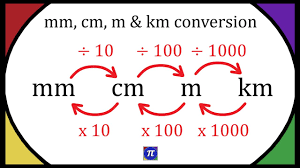CM to MM — Centimeters to Millimeters Conversion
The cm to mm conversion is one of the easiest in the metric system. Both centimeters (cm) and millimeters (mm) are metric units, and the relationship is exact: 1 centimeter equals 10 millimeters. That means to convert centimeters to millimeters you simply multiply by 10, and to convert millimeters back to centimeters you divide by 10. There is no approximation or tricky rounding—just clean, exact math.
If you remember only one rule, make it this: mm = cm × 10. For example, 2.5 cm becomes 25 mm, 12 cm becomes 120 mm, and 0.7 cm becomes 7 mm. The reverse is just as simple: cm = mm ÷ 10. So 125 mm turns into 12.5 cm, 30 mm becomes 3 cm, and 9 mm becomes 0.9 cm. Because the factor is ten, you can do most conversions in your head by moving the decimal point one place to the right (cm → mm) or one place to the left (mm → cm).

Quick answer (perfect for a featured snippet)
How to convert cm to mm?
Use the exact rule: mm = cm × 10.
Examples: 1 cm = 10 mm, 2.5 cm = 25 mm, 12.7 cm = 127 mm.
What are centimeters and millimeters?
Both centimeter (cm) and millimeter (mm) are metric units of length. A millimeter is one-tenth of a centimeter, so there are 10 mm in 1 cm. Because they’re in the same system, conversion is clean and exact—no odd fractions.
- Millimeter (mm): very small distances—screws, watch parts, PCB spacing, 3D prints.
- Centimeter (cm): small everyday sizes—rulers, stationery, fabrics, product specs.
The exact formula (no guesswork)
By definition:
1 cm = 10 mm
mm = cm × 10
cm = mm ÷ 10
That’s the whole story. Multiply by 10 to go cm → mm, and divide by 10 to go back.
Step-by-step: centimeters to millimeters
Method A: Multiply by 10
- Write the rule: mm = cm × 10
- Do the math
- Add the unit “mm”
Example: 12.7 cm
- 12.7 × 10 = 127
- 12.7 cm = 127 mm
Method B (mental math): Move the decimal one place right
- 3 cm → 30 mm
- 0.5 cm → 5 mm
- 21.3 cm → 213 mm
Because it’s just ×10, most conversions can be done instantly in your head.
Real-world examples (so you can use it today)
- 3D printing: a gap of 2.4 cm is 24 mm—useful when your slicer or CAD is set to mm.
- Craft & fabric: a trim of 1.8 cm is 18 mm, easy to mark with mm ticks.
- Hardware: a standoff that’s 3 cm long is 30 mm (common hardware sizes use mm).
- Stationery: a notebook side of 21 cm equals 210 mm (A-series sizes are in mm).
- Photography: a ring of 3.2 cm is 32 mm.
Common cm → mm conversions (quick answers)
- 0.1 cm = 1 mm
- 0.5 cm = 5 mm
- 1 cm = 10 mm
- 1.2 cm = 12 mm
- 1.5 cm = 15 mm
- 2 cm = 20 mm
- 2.5 cm = 25 mm
- 3 cm = 30 mm
- 4 cm = 40 mm
- 5 cm = 50 mm
- 7.5 cm = 75 mm
- 10 cm = 100 mm
- 12 cm = 120 mm
- 15 cm = 150 mm
- 20 cm = 200 mm
Mini chart: centimeters to millimeters
| cm | mm | cm | mm |
|---|---|---|---|
| 0.5 | 5 | 8 | 80 |
| 1 | 10 | 10 | 100 |
| 2 | 20 | 12 | 120 |
| 2.5 | 25 | 15 | 150 |
| 3 | 30 | 18 | 180 |
| 4 | 40 | 20 | 200 |
| 5 | 50 | 25 | 250 |
Need another value? Just multiply cm × 10.
Rounding & precision (do you even need it?)
For cm ↔ mm, rounding is rarely needed because ×10 is exact. If your source has more decimals than you want to display, choose a consistent style (e.g., 1 decimal place) and keep it the same across your page or list.
Examples
- 12.345 cm → 123.45 mm (exact math).
- If you want to show one decimal in mm: 123.5 mm.
Troubleshooting (if your number looks “off”)
- If you got 2.54 involved, you accidentally switched to cm ↔ inches.
- If you divided by 10 instead of multiplying, you did mm → cm by mistake.
- If your result is missing units, add mm—unit mixups are the #1 cause of errors.
Excel / Google Sheets / Code snippets
Excel / Google Sheets
- MM from CM:
=A2*10 - CM from MM (reverse):
=A2/10
FAQs — CM to MM (Centimeters to Millimeters)
How many millimeters are in 1 centimeter?
Exactly 10 mm.
What is the formula for cm to mm?
mm = cm × 10 (exact).
How do I convert mm back to cm?
cm = mm ÷ 10. Example: 125 mm ÷ 10 = 12.5 cm.
Is 0.5 cm the same as 5 mm?
Yes. 0.5 × 10 = 5 mm.
Why do some pages show slightly different mm values?
They shouldn’t for cm ↔ mm. If you see differences, it’s likely rounding style or a typo.
Do I need a calculator?
Usually no. Move the decimal one place right (cm → mm), or left (mm → cm).
Conclusion
Centimeters to millimeters is the simplest conversion you’ll do: mm = cm × 10. It’s exact, fast, and perfect for specs, crafts, 3D prints, and hardware lists. Keep units clear, use a consistent display style, and you’ll never second-guess these numbers again.
